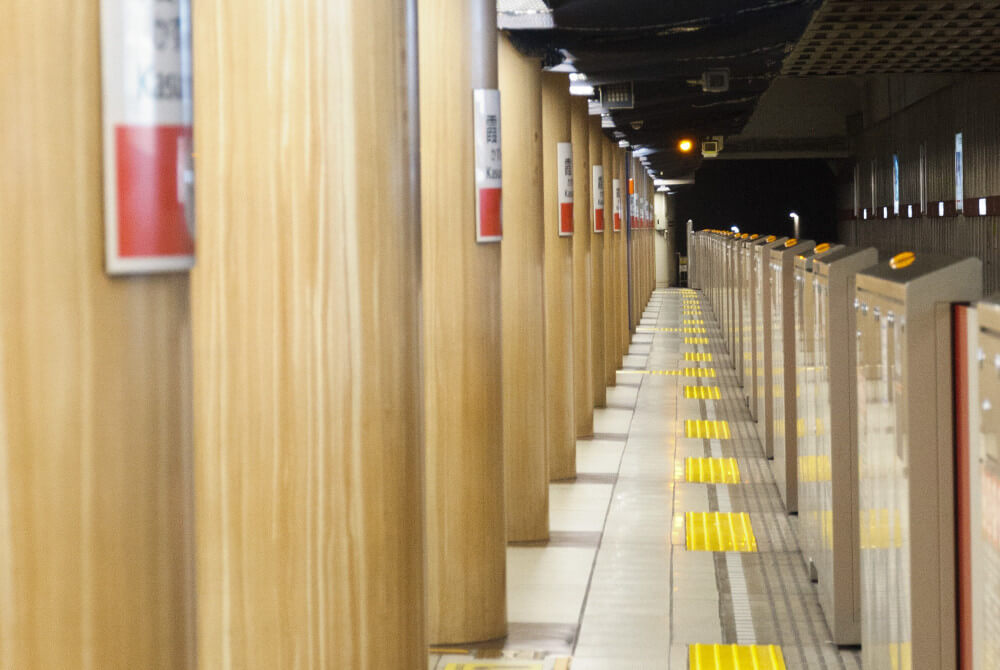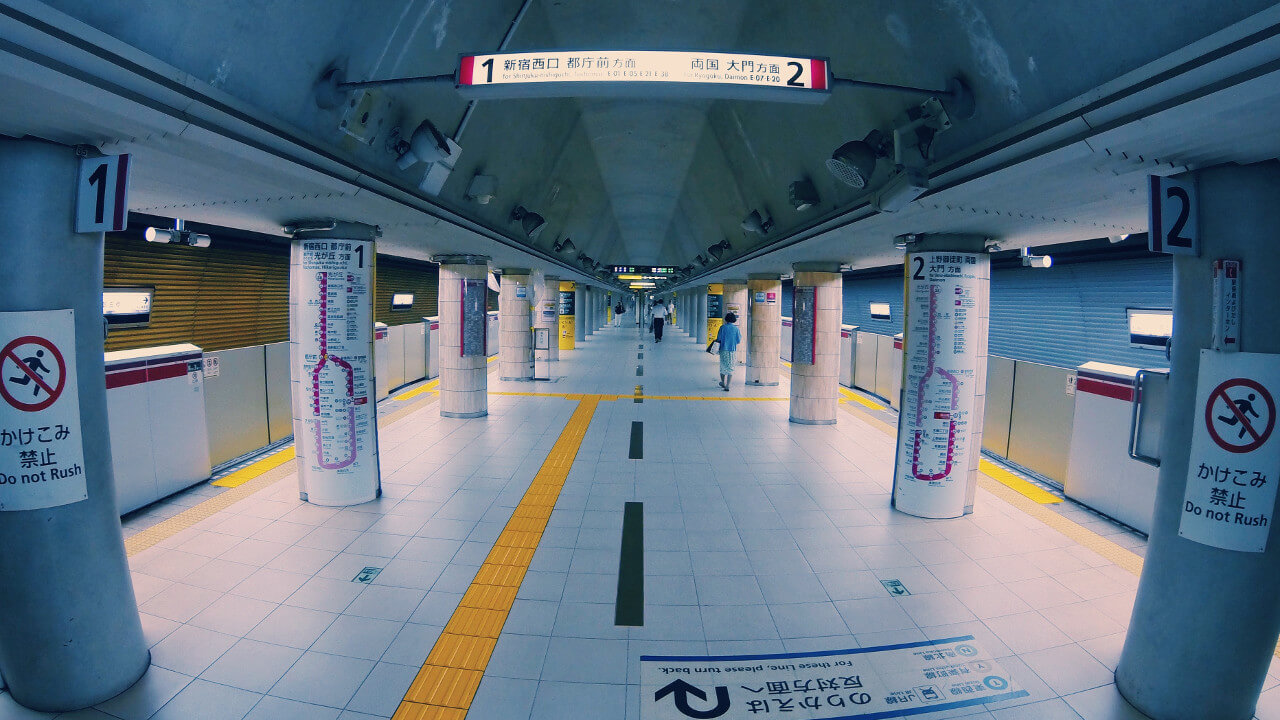Tokyo subway map – The metro network
If there is one city associated with your subway, it is most likely Tokyo. This connection is no coincidence either, because with no less than 3.1 billion passengers a year, the Tokyo subway is the busiest subway network on the planet. However, the sheer mass of passengers is not the only special feature of the 301.1-kilometer-long subway system, but also the fact that the system is actually made up of two networks.
The Tokyo Metro, which was established in 1942 and is operated by the transport company of the same name, takes up the lion’s share of the subway network in Japan’s capital with 9 lines and a route length of 192.1 kilometers.
With a total length of 109 kilometers and 4 lines, the network of the Toei subway, which was founded in 1960, is much smaller. Anyone looking at the Metro Map in Tokyo for the first time will not only be surprised by the numerous lines, but also by their names.
Unlike in Europe, the lines are not uniformly marked with a capital “U” or “M”. The Tokyo Metro Map, on the other hand, uses names that identify each line individually and make it easier to find your way around. Each subway line is assigned a color in addition to a capital letter. For example, the letter “G” and the color red stand for the Ginza Line, which commutes between the Shibuya and Asakusa stops.
Overview of the “Tokyo Metro” subway lines
- (G) Ginza Line (Shibuya ↔ Asakusa)
- (M) Marunouchi Line (Ikebukuro ↔ Hōnanchō / Ogikubo)
- (H) Hibaya line (Naka-meguro ↔ Kita-senju)
- (T) Tozai line (Nakano ↔ Nishi-funabashi)
- (C) Chiyoda line (Yoyogi-uehara ↔ Kita-ayase)
- (Y) Yurakucho line (Wakōshi ↔ Shin-Kiba)
- (Z) Hanzamon Line (Shibuya ↔ Oshiage)
- (N) Namboku Line (Akabane-iwabuchi ↔ Meguro)
- (F) Fukutoshin Line (Wakōshi ↔ Shibuya)
Overview of the subway lines of the “Toei subway”
- (A) Asakusa Line (Nishi-Magome ↔ Oshiage)
- (I) Mita line (Nishi-Takashimadaira ↔ Meguro)
- (S) Shinjuku Line (Shinjuku ↔ Motoyawata)
- (E) Odeo line (Toshomae ↔ Hikarigaoka)
Information for tourists about the Tokyo Metro
Even though the Japanese metropolis’ subway network is gigantic in size, the Tokyo Metro Map is relatively easy to decipher, even for travelers from abroad. Even without understanding a word of Japanese, it is easy to find your way around thanks to the precise marking of the lines based on their block letter designation and color. In addition, most subway platforms in Tokyo are served exclusively by one line and the routes to other platforms are marked by signs and markings on the floor, walls and ceilings.
Travelers also don’t have to remember the names of the numerous stations. These are also marked with a number indicating the direction of travel. The system of capital letters, colors and station numbers makes the Tokyo Metro Map surprisingly easy to use. It is also useful to know that the announcements in the subways are also made in English.
Metro Tokyo: Tickets & Prices
In Tokyo, not only is the subway map structured differently, but also the entire ticketing system. While we in Europe and the USA have classic tariff zones, in Japan we charge more or less by the kilometer. These are typically graduated prices that decrease with increasing distance per kilometer. While a ticket for a single journey on the short route (1-6 km) costs around 170 yen, a journey of 7-11 kilometers costs 200 yen.
However, it only becomes really cheap for long distances to the outskirts of the city, because “only” 310 yen is charged for distances of 28 kilometers or more. In Tokyo, the subway ticket system provides day passes in addition to one-way tickets, which are only valid for a direct trip in one direction. As there are two subway systems in Tokyo, you need to be particularly careful when choosing a day pass. These do not always apply to both networks. It is better to go for the slightly more expensive combined day ticket.
The most important subway tickets in Tokyo
| Ticket | Prices | Buy a ticket |
|---|---|---|
| Single ride | from 170 Yen | available on-site |
| Single ride (reduced 6-12 J.) | from 90 Yen | available on-site |
| Day Pass (Both Subways) | 1.000 Yen | available on-site |
| Day Pass reduced (6-12 y.) | 500 Yen | available on-site |
| Combination ticket (All lines) | 1.500 Yen | available on-site |
| Pasmo Card | 500 Yen (one time) | available on-site |
Germans actually have a reputation for clearly structuring every aspect of public life. When it comes to the subway, however, the Japanese are way ahead of us. While in Germany there are massive problems with fare dodgers and various regulations for validating subway tickets, the Japanese are very pragmatic. There are massive access barriers in front of the subway platforms, which can only be passed through with a ticket purchased from a ticket machine, similar to an airport check-in.
The same game, only in reverse, is repeated when getting off at the destination station. There, the subway ticket is pushed into the locking device and withdrawn. Only then can you leave the station. For example, anyone who has driven too far is prevented from leaving the station by barriers. The corresponding surcharge for the purchased ticket must then be paid at the service point, which is located near the barriers. Fare dodging is therefore not possible.
If you want to travel more comfortably and avoid any problems with your subway ticket in Tokyo, you can buy a Pasmo Card from a machine at the airport or train station as soon as you arrive. The Pasmo Card is a kind of universal subway ticket for Tokyo.
Once the card has been topped up with credit at one of the ticket machines, it can be used as a ticket on both networks. The fare is automatically determined by checking in and out at the respective subway stations. If you wish, you can also use the card to buy day and week tickets from the ticket machines. In addition to the convenience, the Pasmo Card offers a 10 percent discount on all ticket prices.
Tokyo subway timetable
It is obvious that the average intervals between two subways are particularly short in the Tokyo subway network. There is no other way to get the masses of people from A to B smoothly. Accordingly, the Tokyo subway timetable provides for an interval of around two to three minutes between two trains at peak times (7:30-9:00 a.m. & 5:00-7:00 p.m.). Outside rush hour, the standard interval is usually 10 minutes.
To the timetables of the Tokyo Metro lines:
Many lines, such as the busy Ginza line, maintain a tight 5-minute interval even outside rush hours. Like most other subway systems, the Tokyo timetable does not provide for continuous service. Both at weekends and during the week, operations are suspended between midnight and 5:30 am. Night owls therefore have to rely on cabs in the Japanese metropolis. However, due to the enormous demand, these are not only difficult to obtain, but also quite expensive due to the night surcharge of 30 percent.
Further information on the Tokyo Metro
Other countries, other customs. There is hardly any other place where this principle applies as much as in the Tokyo subway. As Tokyo’s subways are particularly crowded at peak times, the operating companies have set up special compartments for women, which men are not allowed to enter. However, white tourists who accidentally end up in a women’s compartment need not fear repression, because the Japanese forgive us “long-noses” for our ignorance.
The use of smartphones in the subway is also frowned upon by the tech-savvy Japanese. In areas of the compartments specially marked with stickers, the following therefore applies: smartphone away and sound off. This rule usually applies to the seating areas at the end of the carriages, which are intended for children, senior citizens and pregnant women.




